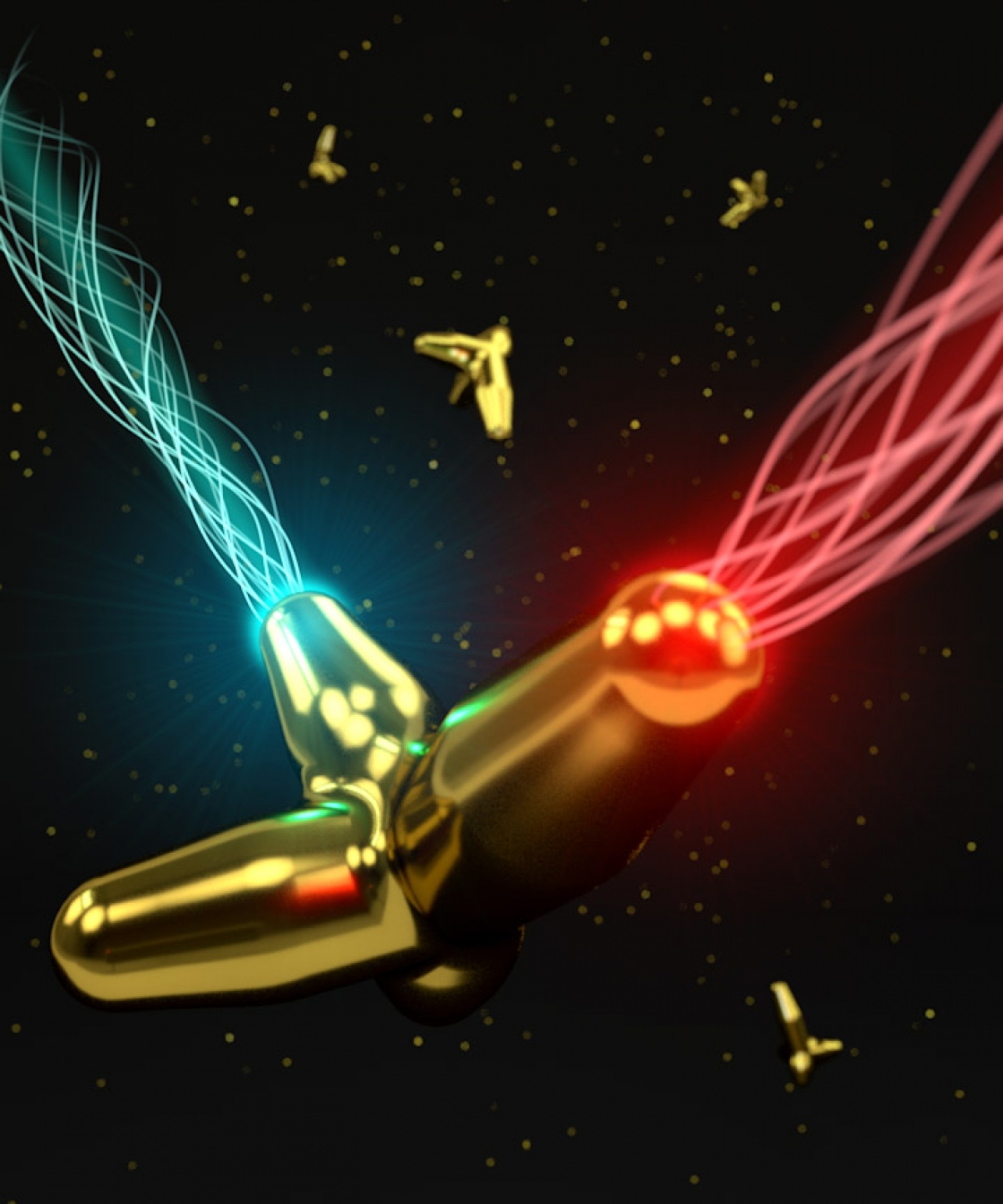The golden touch
Gold is a key to the nanostar’s usefulness. The first thing you notice about gold is its brilliant shine, Nesbitt said, and that effect only gets stronger as the particles get smaller.
“It’s the material that provides a terrific hook to bring photons into it…Gold has these marvelous properties that allow it to have exceptionally strong interactions with light in the visible [spectrum], where many ultrafast lasers operate. As you shrink [gold] down to the nanoscale, it interacts more strongly per volume.”
Scientists have exploited this unique characteristic since the days of alchemy. Tiny particles of gold were embedded in glass to create red stained glass for medieval cathedrals. When white sunlight hits the particles in the glass, the gold absorbs blue light and transmits deep ruby red light.
Unlike light through a stained-glass window, Pettine and Nesbitt need to draw light into the gold nanostars and concentrate it at specific “hot spots.” That’s where the nanostars’ shapes come in handy.
A star is born
The gold nanostars in the Nesbitt Lab are shaped like toy jacks or caltrops, with pointy arms protruding from their small center. With a specialized “recipe”, the lab’s collaborator at Northwestern University grow the nanostars like crystals in a cave to reach the right size and shapes.
No two stars are exactly alike, with different arms of different lengths pointing in various directions. Those arms act like antennas, drawing in light from the laser, Nesbitt explained.
“Think of the nanostar just as being an old-style television antenna…pointing in different directions and able to bring in different stations as a result,” Nesbitt said. “The stations that these nanostars are communicating with are different colors of laser light.”
The electrons at the tips of these antennas are able to “tune in” to the energy coming from the laser light. But now, they need some direction.
Steering on the Fermi sea
There are millions of free-floating electrons inside the gold nanostars, collectively known as the Fermi sea. Hit the electron sea with light and it creates waves. Without direction, the electrons will just bob up and down in place, like a cork on the ocean.
That’s why the asymmetric antenna-like arms of the nanostars are so important. Electric fields collect near their sharp points, Nesbitt pointed out. As electrons slosh along the elongated arms, they pile up at the sharp tips and create a hot spot.
The electrons stream off this hot spot in a process called photoemission, or the photoelectric effect.
“When electrons build up at these really sharp tips, they can shoot out in a certain direction…If the electrons were just going back and forth, the electrons have energy but we can’t do much with it. Once you actually kick them off in a certain direction, that’s when you get useful current,” Pettine explained.
Pettine found that by changing the polarization and/or color of the laser, he could change which tips the current flowed through, and how many electrons spilled out.
“This is where the steering idea comes in,” Pettine added. “For instance, we change the angle of the light—the polarization of the light—and we see that as we do that, the angle of the emitted electrons changes.”
In this study, Pettine and his group created a detailed map to show exactly which light colors/polarizations couple to any particular tip. This kind of control is promising as a step toward new computers and technologies using electron beams, such as electron microscopy or electron diffraction.
“Part of this paper is showing that we can do this experimentally, and the other part is introducing a full model that we can then apply to other nanoscale systems…So, the nanostars are just a good prototypical system to illustrate these behaviors,” Pettine said.
You can read the full study in Nature Communications. This research was supported by the Air Force, the National Science Foundation’s Physics Frontier Center Grant, and a National Science Foundation Graduate Research Fellowship.



 The Physics Frontiers Centers (PFC) program supports university-based centers and institutes where the collective efforts of a larger group of individuals can enable transformational advances in the most promising research areas. The program is designed to foster major breakthroughs at the intellectual frontiers of physics by providing needed resources such as combinations of talents, skills, disciplines, and/or specialized infrastructure, not usually available to individual investigators or small groups, in an environment in which the collective efforts of the larger group can be shown to be seminal to promoting significant progress in the science and the education of students. PFCs also include creative, substantive activities aimed at enhancing education, broadening participation of traditionally underrepresented groups, and outreach to the scientific community and general public.
The Physics Frontiers Centers (PFC) program supports university-based centers and institutes where the collective efforts of a larger group of individuals can enable transformational advances in the most promising research areas. The program is designed to foster major breakthroughs at the intellectual frontiers of physics by providing needed resources such as combinations of talents, skills, disciplines, and/or specialized infrastructure, not usually available to individual investigators or small groups, in an environment in which the collective efforts of the larger group can be shown to be seminal to promoting significant progress in the science and the education of students. PFCs also include creative, substantive activities aimed at enhancing education, broadening participation of traditionally underrepresented groups, and outreach to the scientific community and general public.